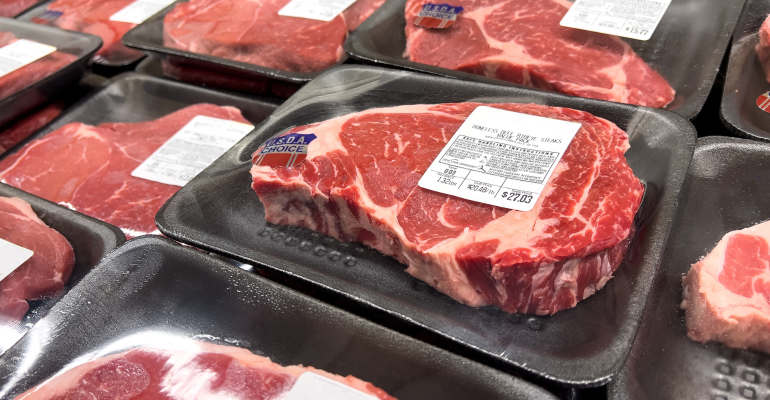Grocery price inflation appeared to be slowing in January, according to research from Circana and 210 Analytics, and sales in most categories showed signs of growth.
The average price per unit across multi-outlet stores, including supermarkets, club, mass, supercenter, drug, and military, increased by 0.9% in the four weeks ending Jan. 28, compared with January 2023. That included a 0.3% decline in the average price per unit for all perishables departments, and a 2% increase for dry groceries.
“Despite price increases slowing down, 93% of consumers in the January Circana shopper survey remained concerned over grocery prices,” said Anne-Marie Roerink, president, 210 Analytics.
She noted that with Easter falling on March 31, the upcoming holiday selling season will be shorter than it has been in several years.
“If Thanksgiving, Christmas, and New Year’s patterns hold, the sales peak will likely shift back to the holiday week itself instead of the week prior,” Roerink said, adding that the average party size has crept up to 8.2 people, and that consumers expect to spend “a little more than last year.”
Meat sales inch upward
As meat prices remained relatively stable in January vs. a year ago, sales in both dollars and pounds experienced a slight uptick. Dollar sales rose 2.5% in January, to $6.6 billion, including a 3.7% gain for fresh meat, slightly offset by a 0.1% decline in dollar sales of processed meat.
Fresh turkey was among the standout categories in January, with dollar sales up 6.4% and pounds rising 7.8% vs. a year ago. Fresh beef also had dollar sales gains of 6.4%, mostly driven by inflation as pounds were up only 0.6%.
“Turkey breast in particular had a very strong start of the year, perhaps hand-in-hand with consumers’ New Year’s resolutions,” Roerink said in the monthly meat report.
A separate Circana/210 Analytics report on plant-based meat alternatives found that combined fresh and frozen sales were down 5.2% in January, to $85.6 million, and down 8.4% in units. Total sales for the last 52 weeks were still slightly over $1 billion, down 11.1% vs., the preceding 52-week span.
Produce sales reflect larger pack sizes
Dollar sales of fresh produce were up 1% in January, compared with a year ago, to $5.8 billion. The data show that while unit sales of produce were down 0.3%, however, volume in pounds rose 0.7%, reflecting a shift to larger pack sizes, particularly in commodities with longer shelf-life, Roerink said.
She noted that produce sales patterns mirrored those in the meat department, with strong sales in the first two weeks of January and lagging in the second half of the month.
She also noted that fresh produce experienced only mild price increases in January and for the 52-week period, relative to a year ago, although vegetable prices decreased in January, driven at least in part by more and deeper promotions.
Deli sales notch broad gains
Other than a slight dip in deli meat sales, all other deli categories saw sales gains in January relative to a year ago. Overall the deli department had dollar sales gains of 1.3%, reaching $3.5 billion, and unit sales gains of 1.6%.
“Deli-prepared foods remain a bright spot in grocery retailing,” said Roerink in the report. “As consumers balance cost vs. convenience, prepared foods are hitting a sweet spot and are increasingly stepping up as true restaurant alternatives.”
Prepared meats (up 10.1% in dollars and 11% in units), soups and chili (up 14.6% in dollars and 15.3% in units), and desserts (up 13.1% in dollars and 8% in units) were the biggest gainers in deli-prepared foods.
Frozen foods a mixed bag
Pizza, processed meat, and baked goods were among the best-performing categories within frozen foods January, according to the Circana data. Frozen baked goods saw dollar sales up 7.1% vs. a year ago and unit volumes up 4.5%, while dollar sales of frozen pizza were up 5.7% vs. a year ago, with unit volumes up 4.3%. Processed meat saw a spike in unit volume, up 6.4%, although dollar sales only grew by 1.1% as the average price per unit fell 1% year-over-year.
Overall, frozen food prices were up 5.4% on a 52-week basis, although they were virtually flat at +0.3% on a monthly basis. Frozen beverages and fruits and vegetables both experienced unit-price inflation in double digits on a monthly basis in January, while meat, processed meat, seafood, and meals experienced deflation.
Seafood sales erode
Sales of both fresh and frozen seafood declined in January, compared to year-ago levels, in both dollars and pounds. Sales of ambient seafood, meanwhile, was up slightly, driven by gains in both sardines and tuna.
The seafood report found that prices per pound decreased for both frozen and fresh seafood in January, compared with a year ago, and the price per unit decreased for shelf-stable seafood.
“However, at an average price per pound of $9.26, the cost for fresh seafood remained significantly higher than the average price per pound for the three biggest animal proteins of chicken ($3.05), pork ($3.20) and beef ($6.15),” Roerink said.
She also noted that shellfish, which had seen strong volume sales amid price deflation in the first half of 2023, “could not hold the line on volume sales” in January of this year, when year-over-year volumes were down 4.2%.





